Baidu Webmaster Tools is a portal created to help webmasters and SEOs monitor and maintain their site’s presence in Baidu’s organic search results. The platform offers a great deal of metrics you can only get from Baidu, tools to test your site’s performance, and a two-way communication channel between you and Baidu. This means that if you are doing SEO in China, Baidu Webmaster Tools is an incredibly important tool you will have to master.
However, there’s one big obstacle facing SEOs outside of China — the tool is only available in Chinese. You could in theory use Google Translate, but this can be cumbersome, inaccurate, and does not translate technical terms well. So until now, unless someone on your team reads Chinese, managing your site on GWT has been a frustrating experience.
But never fear — we’ve provided this detailed, comprehensive guide to Baidu Webmaster Tools to help non-Chinese readers understand how to navigate the platform and get the most value out of it — without having to know a single Chinese word!
(Last Update: Nov 2017)
So what can you do on Baidu Webmaster Tools? We’ll take a look at each of these main features in detail below:
In order to start using Baidu Webmaster Tools, you first have to sign up for a Baidu account.
Unfortunately, even at this first step, the frustration can begin — account registration for Baidu requires a China mobile number for SMS verification. If you don’t have a China mobile number, we have a specific method for registration without a China phone number (see below).
If you have a local China number, then the registration process is pretty straight forward.

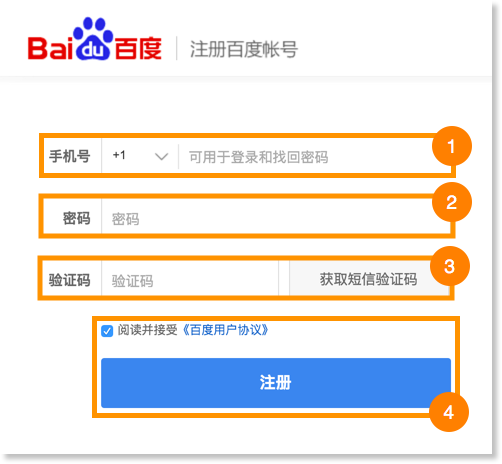


Upon successful login, you can start adding sites to Baidu Webmaster Tools (Login required).
The first step is to enter your site’s home address and whether your site is HTTP or HTTPS site. Baidu recommends adding a site’s main or www. subdomain to their Webmaster Tool first, since it will make adding other subdomains easier later. Click 下一步 (Next) after you’ve done so:
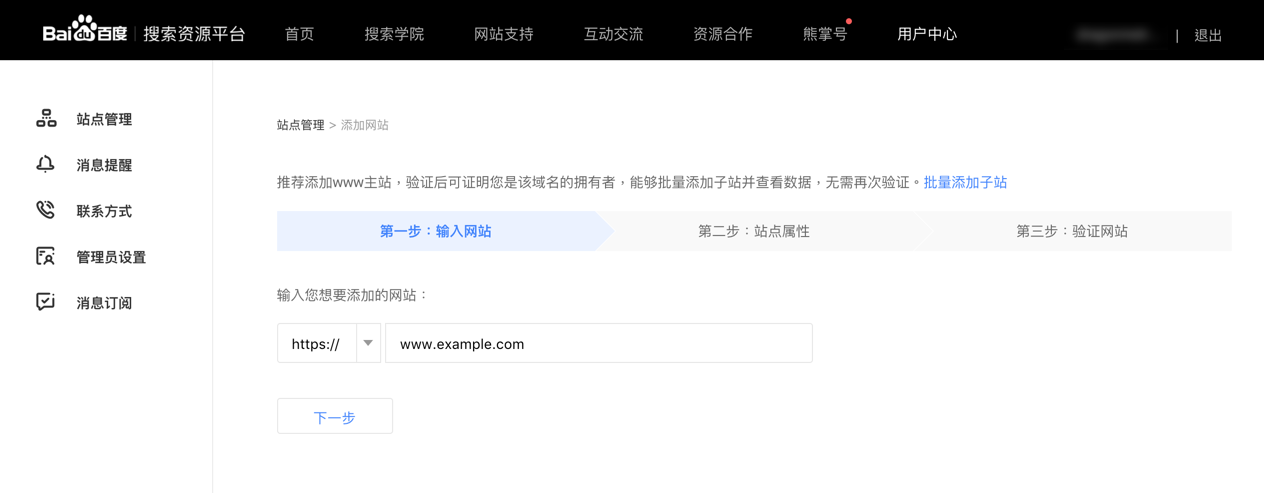
After entering your website’s home address, you will need to tell Baidu the industry categories your site is about – Here‘s their English translation from Google Translate.
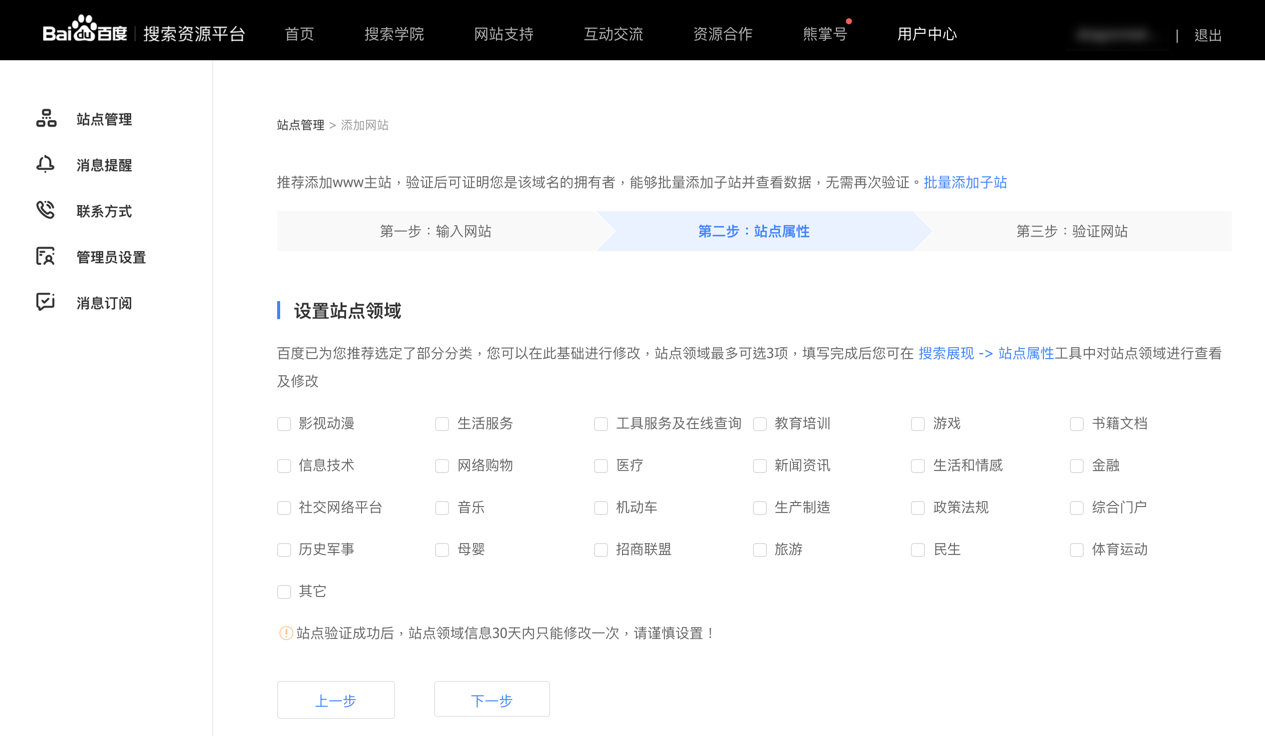
Similar to Google Search Console, Baidu Webmaster Tools offer three ways for users to verify their sites:
We will be using HTML tag verification in this tutorial since it can be the easiest for SEOs to control, as we may not have access to the FTP server or DNS settings.
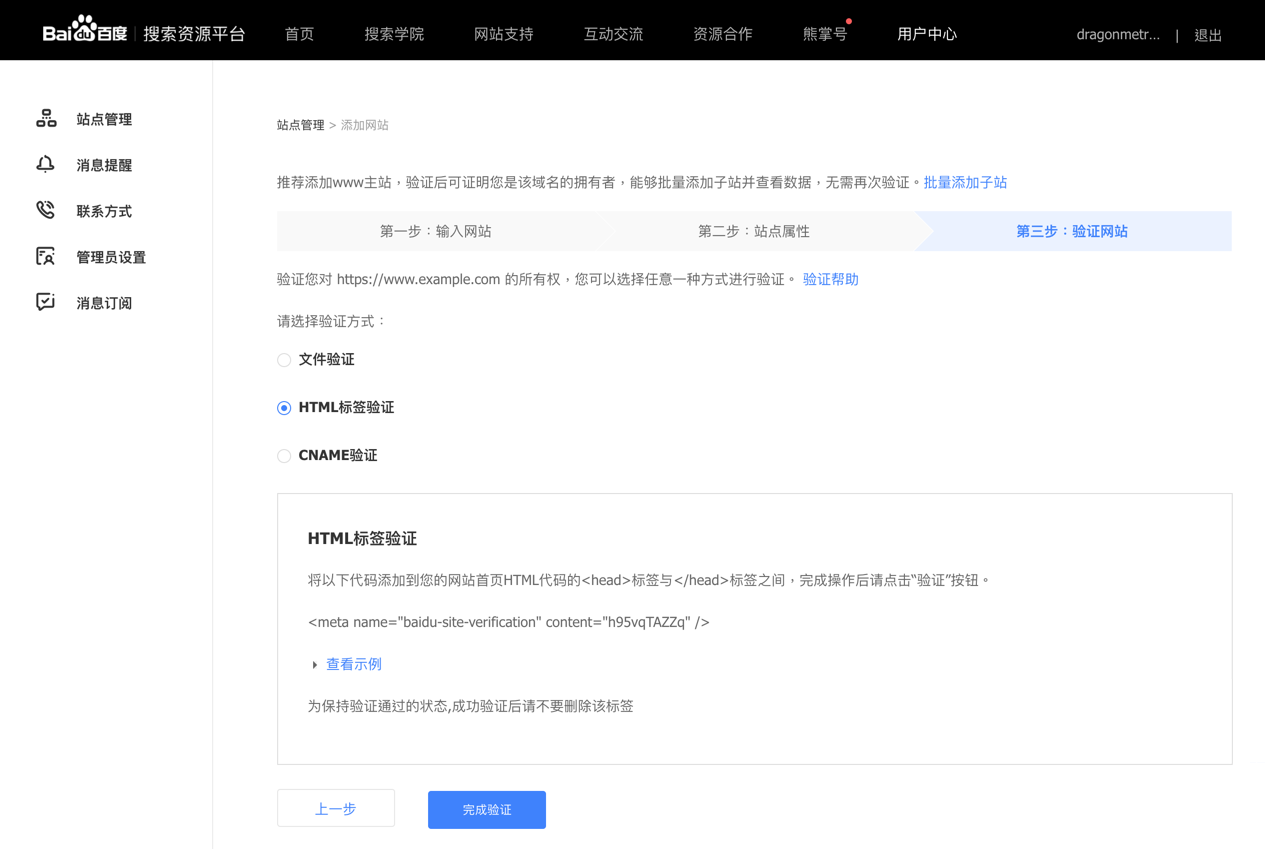
<html>
<head>
<meta name=”baidu-site-verification” content=”xxxxxxxxxx” />
<title>My title</title>
</head>
<body> page contents </body>
</html>
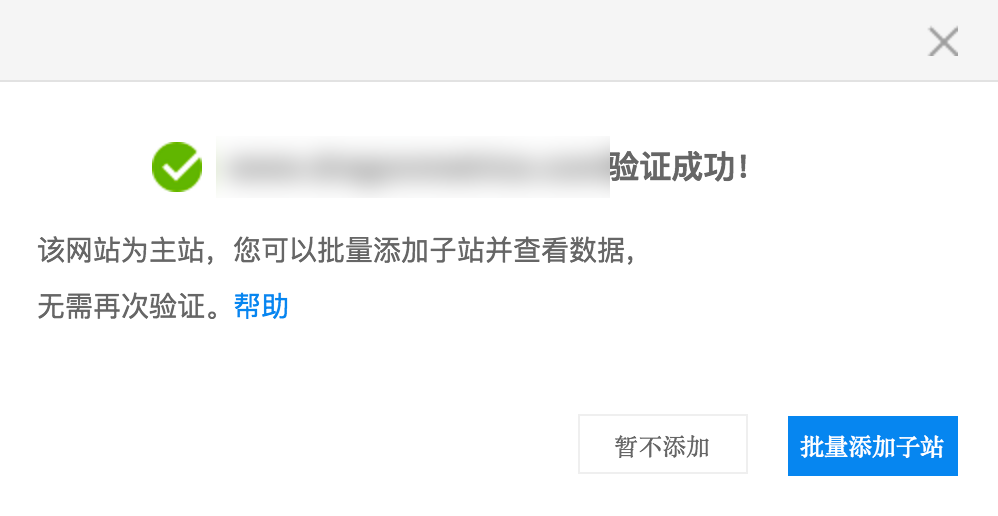
This screen will be shown upon verification success. It will prompt you to add subdomains by clicking on the blue button 批量添 子站 if you wish, otherwise you can just click 暂不添 to proceed.
After you’ve verified the site, DON’T remove these tags or files! In order to maintain the verification status, Baidu recommend users keeping the files, HTML and records since they will use these to check their user’s verification from time to time.
If you get an errors on verifying your site, here are the common verification errors and their recommended solutions:
| Error text | Translation | Recommended solutions |
|---|---|---|
| 法解析您网站的域名 | Unable to parse site’s domain name | Please check if site’s DNS settings are correct, and update your own website DNS |
| 法连接到您网站的服务器 | Unable to connect web server | Check if web server settings are correct and can be accessed normally |
| 获取验证文件或网页发生错误 | Errors getting the verification file or Web page | Check server settings, or try again later |
| 您网站跳转次数过多 | Excessive redirects | Check server settings, see if multiple redirects are in place, if so cancel them and try verifying again |
| 服务器检查结果为空 | Server checks result is null | Please check if the server have settings specifically for Baidu (for example: Baidu are banned) and try again later |
| 我们 法访问您的网站 | Site inaccessible | Please check if the server settings are correct, if your site is blocking Baidu’s UA / IP, try to verify your site after lifting those restrictions |
| 找不到验证的html 签或者验证的html 签内容错误 | Can not find HTML validation tag or the html tag is incorrect | Please check if the html tag content is correct |
| 验证的文件内容错误 | Validation file error | Please check if the validation file is correct |
| 没有找到对应的DNS CNAME记录 | Corresponding DNS CNAME record not found | Check if the DNS settings are correct for your website |
| 您的网站跳转到另一个域名下 | Website redirected to another domain name | Please check if the server has redirect set up, if so please cancel them and try re-verifying |
If you’ve Baidu Analytics (Tongji) installed on your site, you can add your site directly in Baidu Webmaster Tools without verifying, but we won’t be covering this method here.
If you only have time to learn one thing about the whole tools after setting up your account, the Baidu Webmaster Tools Dashboard will probably be the one. The Dashboard of the Baidu Webmaster Tools gives users high level overview of all the data available inside the tool. This dashboard is not customizable, and below are the description of each component.
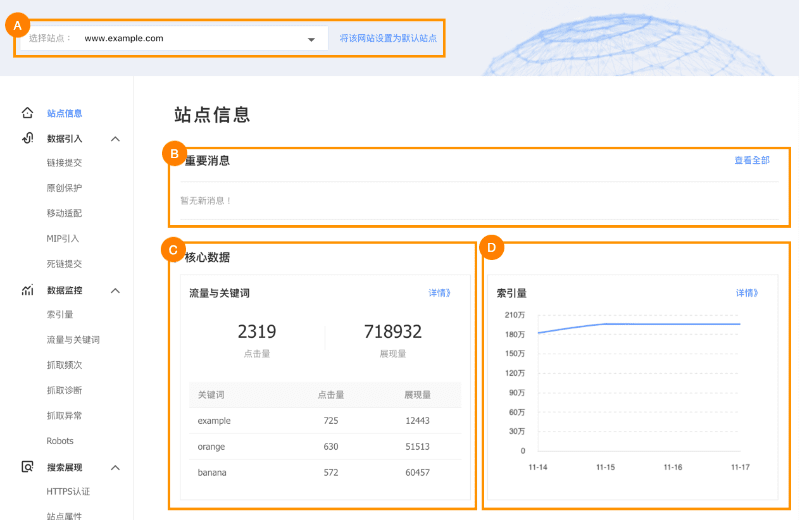
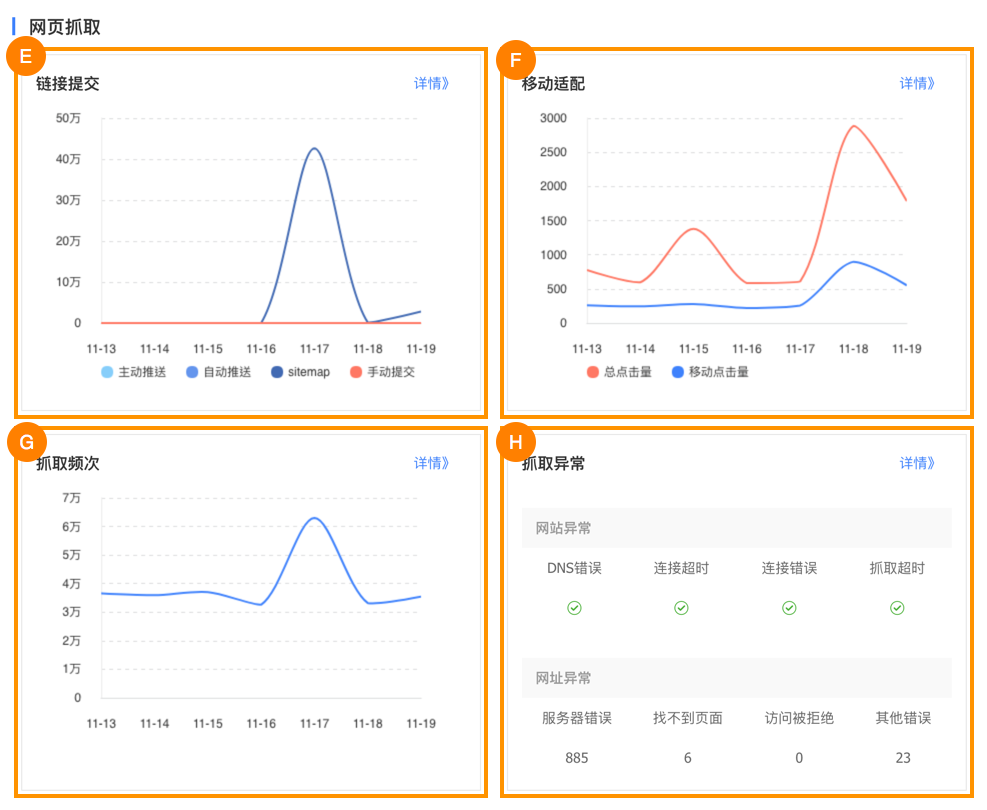
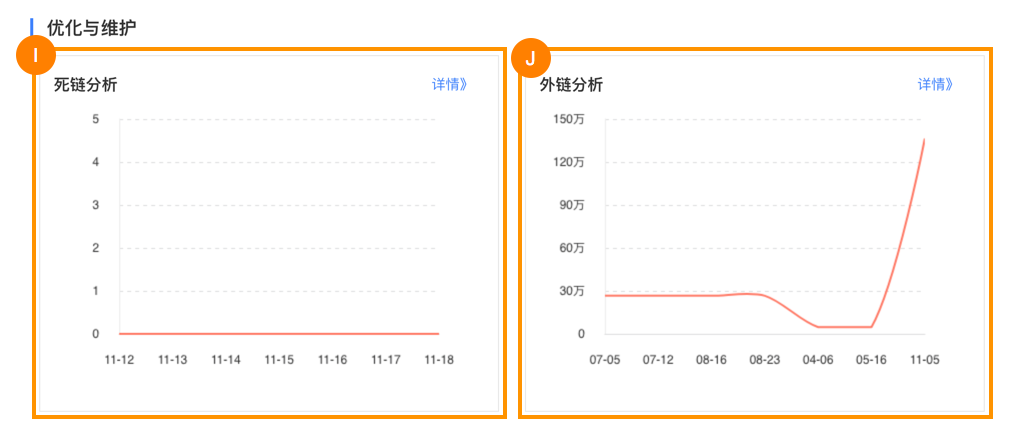
Baidu started supporting HTTPS websites since 2015 however China SEOs has been complaining that the indexation for HTTPS websites haven’t been great (Some even reported huge traffic loss for extended period of time). However Baidu has been improving their ability in crawling HTTPS pages and we’ve seen more and more China websites started using HTTPS for all their pages in the past year.
Recently, Baidu released a HTTPS Validation Tool that allow SEOs to trigger a validation of whether their site is a valid HTTPS site or has been successfully migrated to HTTPS, and provide a quick index update for the HTTPS site once validated.

The tool is pretty straight forward to use – You visit the page and there’s only 1 button on the page, once you’ve confirmed your site’s HTTPS implementation status, you can click on the button and Baidu will immediately start checking whether your site’s HTTPS status, and update their index within a day accordingly.
Fake official websites has been an issue for Baidu SEOs for years. Experienced black hat SEOs in China often look for global brands with lack of SEO efforts in Baidu, creating fake websites that rank for brand terms of these companies before they do, and trying to sell their fake websites back to the company, or resell their leads to their competitors for profit.
To help fight this issue, Baidu’ve recently released a brand terms protection tool which allow legitimate website submitting up to 3 brand terms they should rank for but aren’t because of fake websites. With this tool you can also report to Baidu for fake websites. Let’s look at the tool together:
Inside the page, you’ll be able to:
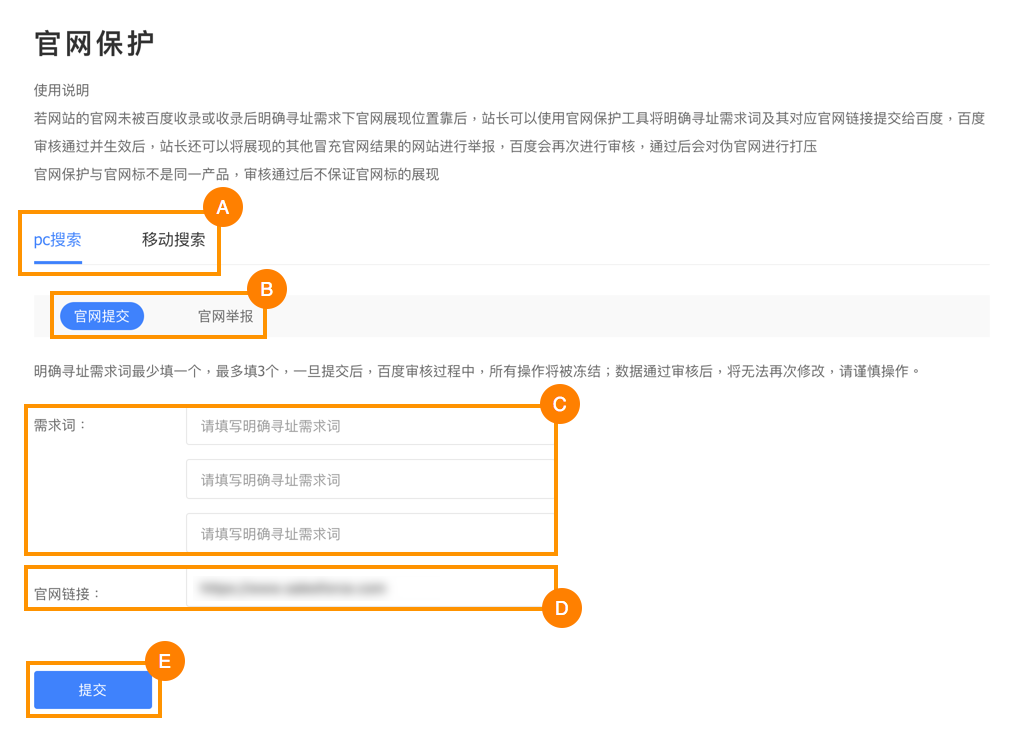
The first thing you should bear in mind is that this tool is created for websites who’re suffering from fake websites ranking above them for their brand terms, so if your site is not having this issue, Baidu likely won’t accept your application as there’s nothing need to be fixed on their end.
Time required for Baidu to process brand protection application is normally within 15 days. Also the Brand Terms Protection tool is a different feature than the “Official website tag” (Where you will see “官网” next to the search snippet, learn more about rich snippets in our Baidu SERP Features article) and they do not affect each other.
Submitted terms will need to be closely related to your brand, here are some examples:
Eligible
Not Eligible
Baidu currently offers 4 methods for submitting content. To ensure best indexation, we recommend implementing all of them if possible:
Submitting links will help Baidu discover your new content, however this doesn’t guarantee indexation and rankings.
We will be demonstrating the Auto Push method, since we believe this will be suitable for most SEOs. Simply copy the following JavaScript code, and paste it into every page of your site. If you are using a CMS like WordPress, you can paste this code into the head tag of the header.php file of your theme.
<script>
(function(){
var bp = document.createElement('script');
var curProtocol = window.location.protocol.split(':')[0];
if (curProtocol === 'https') {
bp.src = 'https://zz.bdstatic.com/linksubmit/push.js';
}
else {
bp.src = 'http://push.zhanzhang.baidu.com/push.js';
}
var s = document.getElementsByTagName("script")[0];
s.parentNode.insertBefore(bp, s);
})();
</script>
After doing so, every time when a page is browsed on your site, the page’s URL will be pushed to Baidu automatically, thus ensuring new content being submitted to Baidu.
You can track your submission stats overtime in Baidu webmaster Tools as well. In the screenshot below, you can see that the site is primarily relying on sitemap for URLs submission (The purple line).
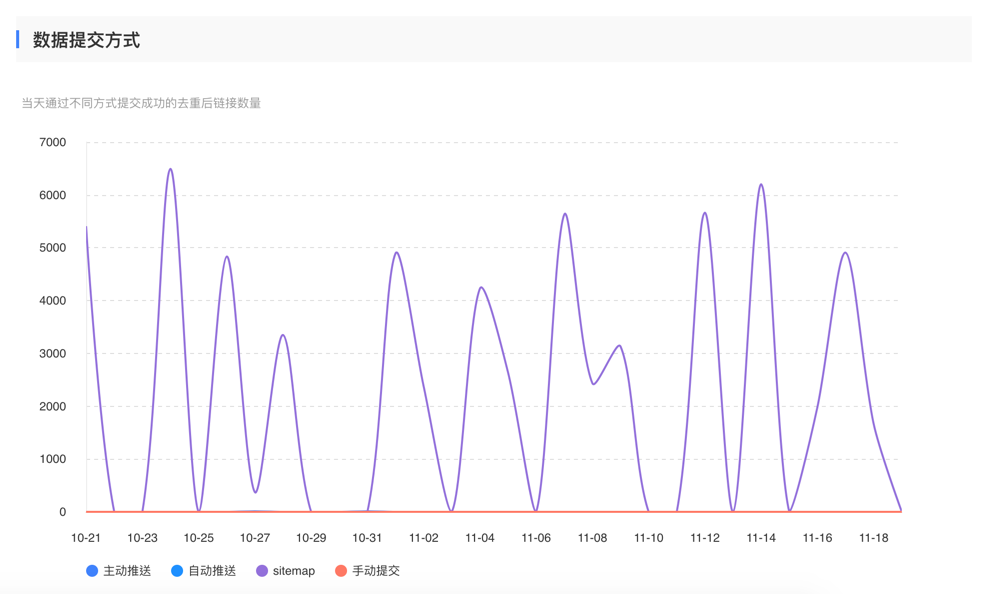
Having too many broken links on your site will negatively affect your site’s user experience, traffic, conversions and indexation — especially if they’re showing up on Baidu search results pages. You can use the Broken Link Submission Tool (死链提交) to inform Baidu your sites’ broken links.
There are two methods you can use to submit broken links: File submission and rule submission. We will be demonstrating File Submission in this article:
A. Here you can see the status and stats for your submitted broken links file
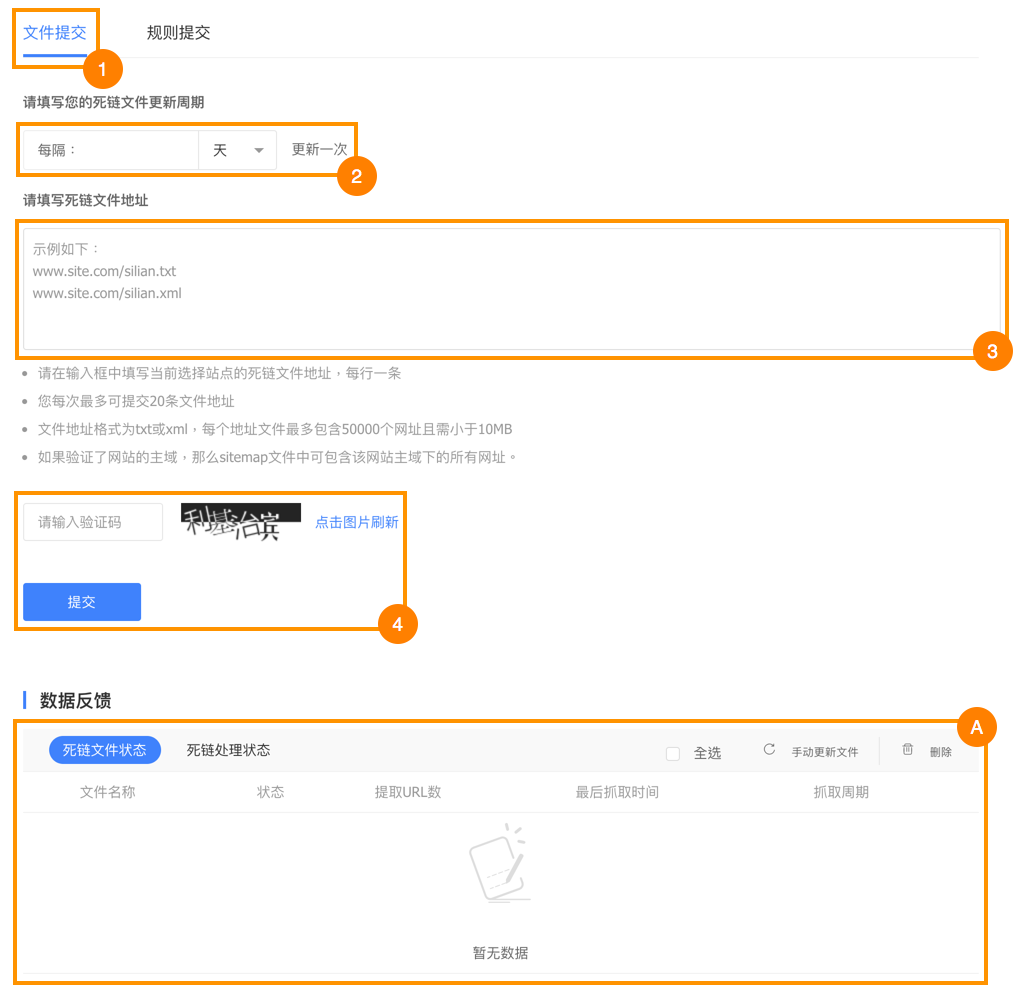
Both.txt and .xml file formats are supported for broken link files. Each file can contain up to 50,000 URLs, and cannot be larger than 10 Mb.
Baidu Webmaster Tools offer users the ability to notify Baidu when you move to a new domain, or shuffle content around on your site by using the Site Migration Tool (网站改版工具). You absolutely should use it when migrating your site. The tool currently support the 3 types of migrations:
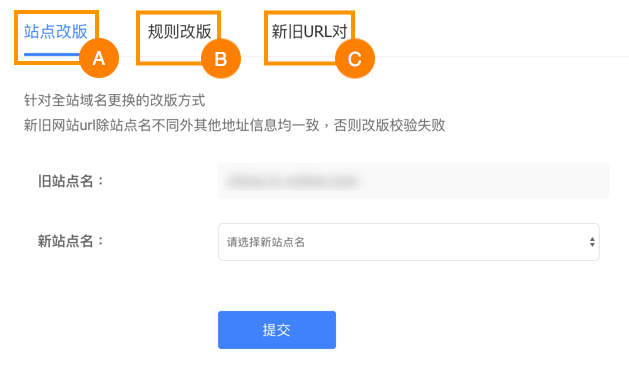
We will be covering Change of domain (站点改版) and URLs pairing (新旧URL对) in this tutorial.
This tool will notify Baidu of the changes to links in your site. Changes of content will not be taken into account.
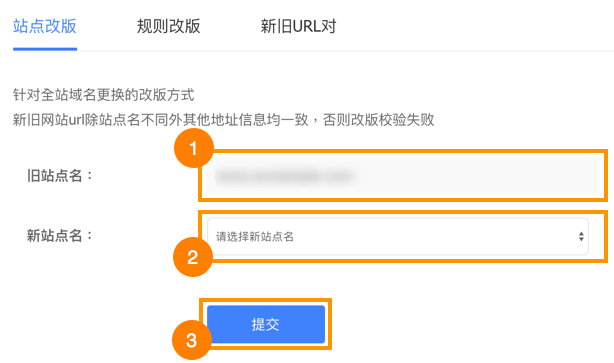
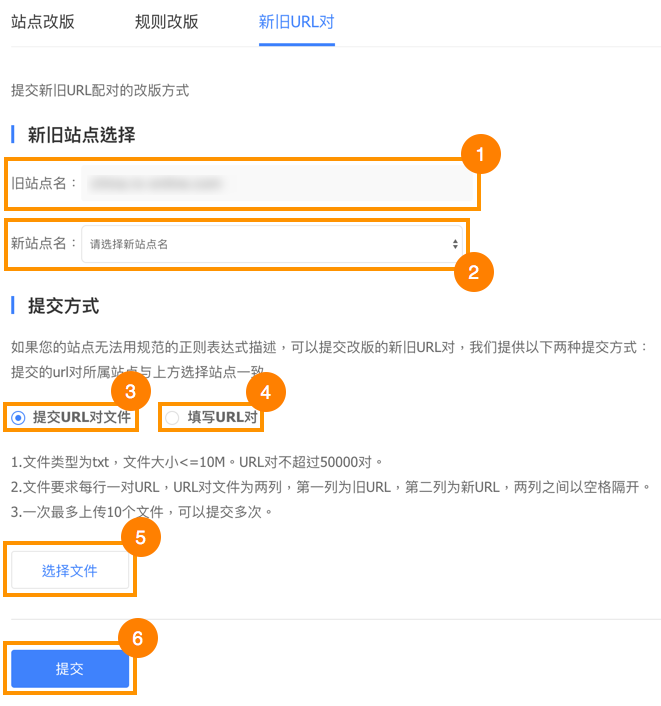
These errors will be shown in samples in the tool interface.
A site’s indexation is the number of pages on a site that are in the search engine’s database and available to be shown in search results. This is important because if your pages are not even indexed in a particular search engine, there is no chance they can have any ranking for any keyword.
One of the simplest method to get indexation data is to use the “site:” search operator, however this number as we all know, is not accurate.
To get a site’s accurate indexation on Baidu, you should use the Indexation Volume tool (索引量) in Baidu Webmaster Tools.
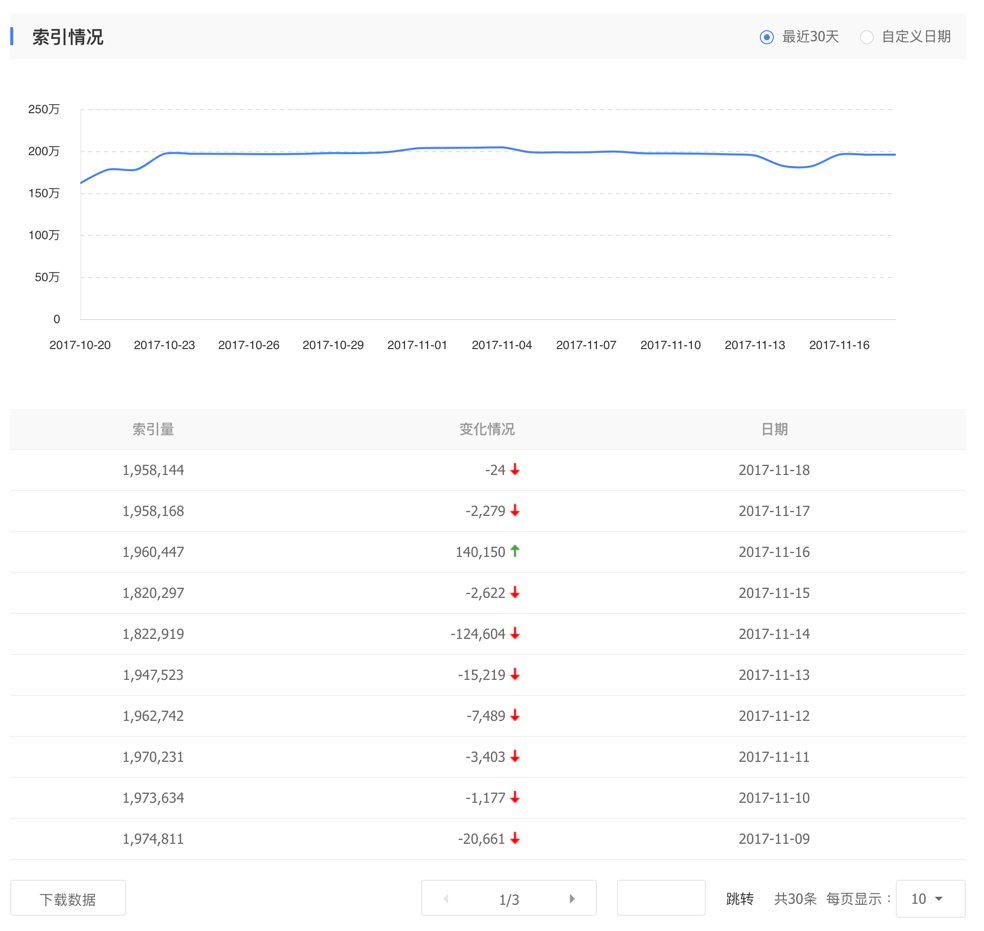
By adding custom rules in the indexation tool, you can check a particular directory or subdomain’s indexation volume as well. Custom rule can be defined by inserting “*” into your site URL, placing “*” at the end of the URL after “/” you can get the page’s and all subfolders’ indexation for that URL. If you add the “*” in other position before “/”, you can get indexation data for that directory, here are some examples:

Probably the most important feature for any search engines’ webmaster tools is to check for ranking keywords and their impression and clicks. In Baidu Webmaster Tools’ Traffic and Keywords (流量与关键词) section, webmasters can get their sites’ impressions and clicks from Baidu organic search results in a daily, weekly and monthly level, as well as the impressions and clicks for your sites top keywords for the last 30 days. Top landing pages are also provided so you can get a sense of how your pages are performing in Baidu. There is a maximum of 50,000 rows on each report.
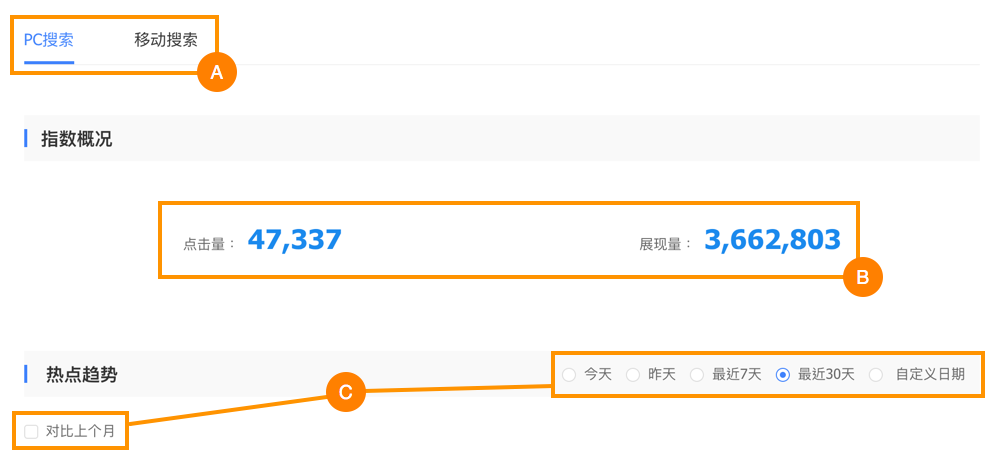
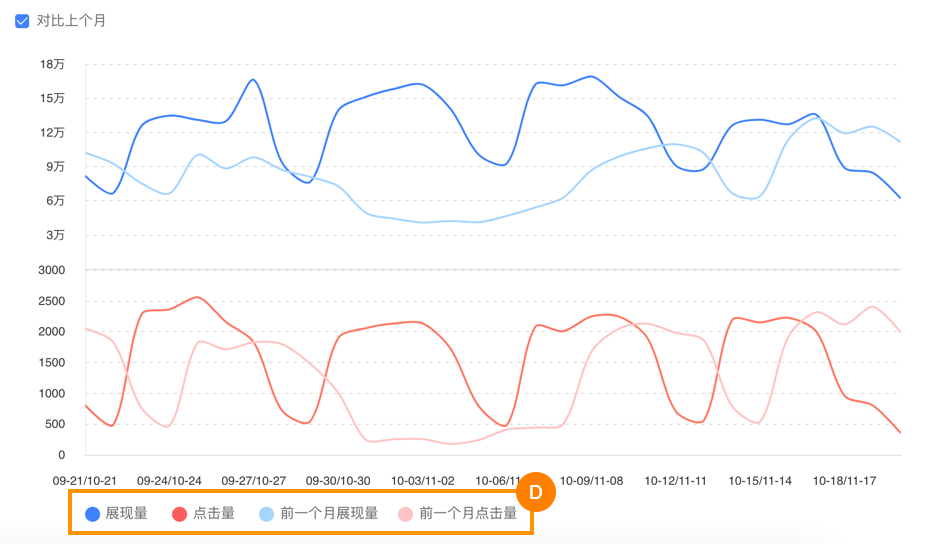
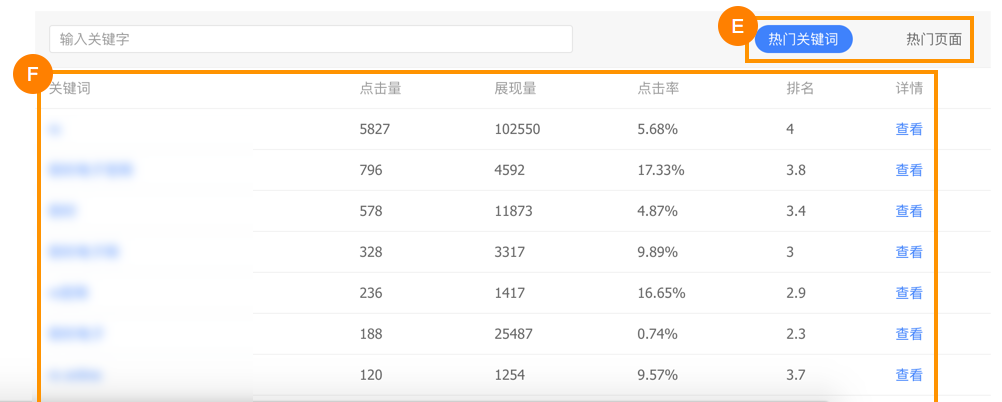

When you are viewing mobile data on this page, you can view data for All Pages (全部), Mobile Pages (移动页), Encoded Pages (转 页) or Desktop Pages (PC页). This will give you a better idea of how’s your site performing on Baidu Mobile if you have different types of mobile pages on your site.

If a site has a lot of crawling errors or uncrawlable content, search engines will rank them lower and index less pages, since they offer a poor user experience. With Crawl Error Tool (抓取异常工具) in Baidu Webmaster Tools, you can see how successful Baidu spiders are able to crawl your site over time.
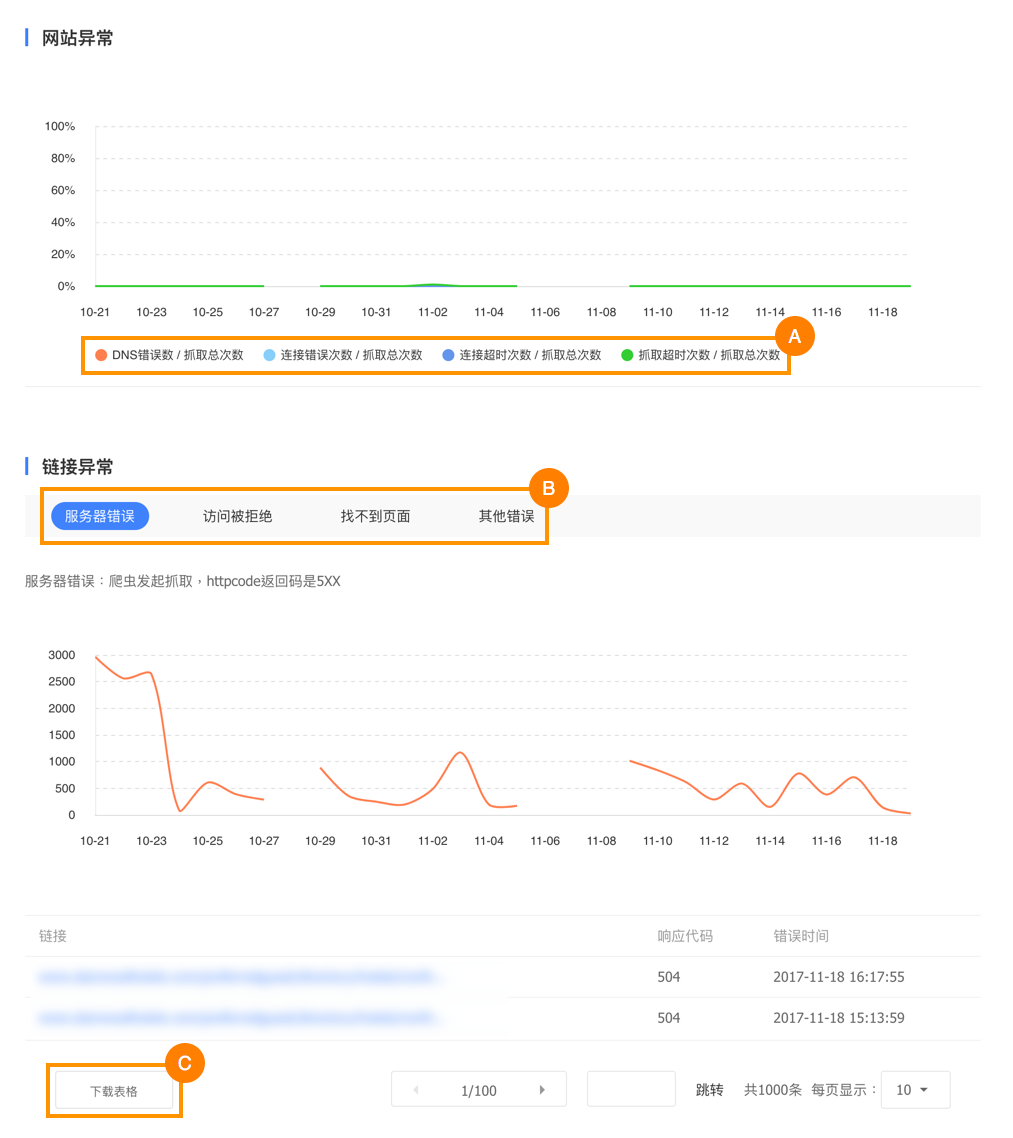
If your 404 links are shown in this tool, you won’t need to submit broken links for these links to Baidu
Within Baidu Webmaster Tools you can diagnose potential SEO issues by checking using Crawl Diagnostic Tool (抓取诊断). 200 fetches are available for each site every week, and the fetch results will only show content of the first 200 KB of content.
Within the crawl detail page, you can:
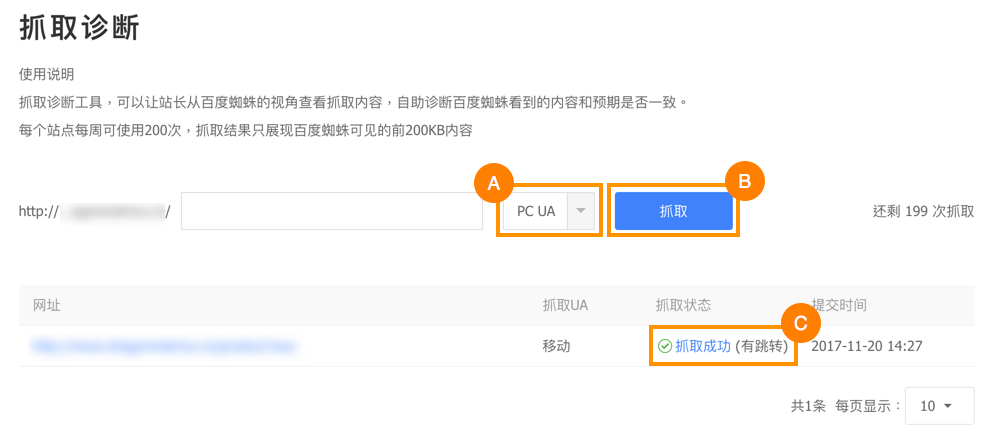 Result page of the crawl test:
Result page of the crawl test:
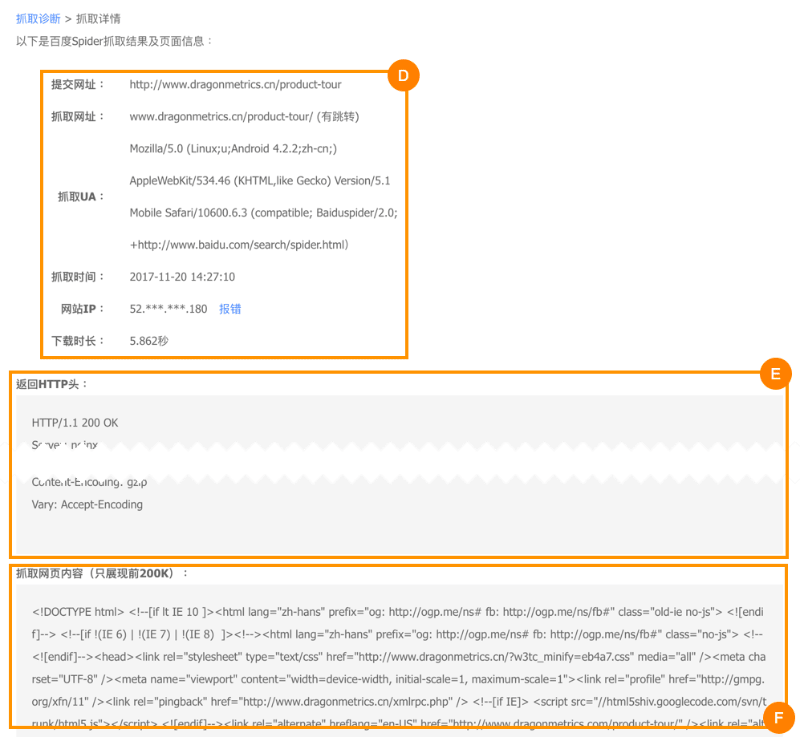
Look at the number of broken links in your site Baidu’s found over time:
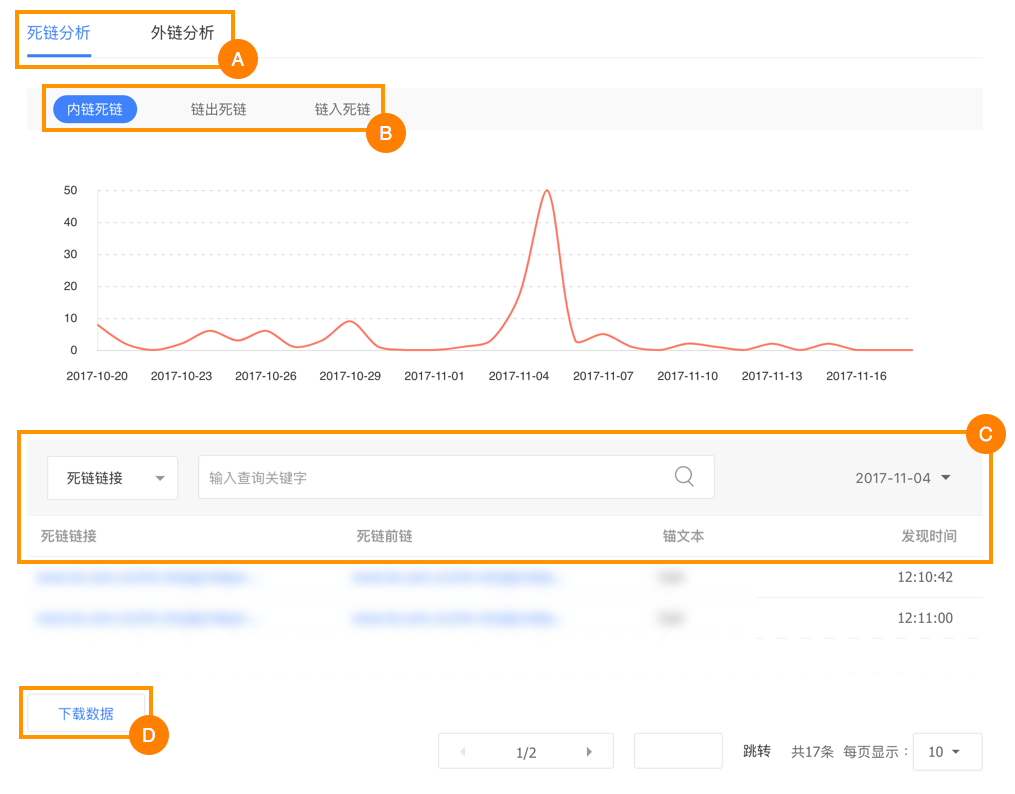
With Baidu Webmaster Tools Backlink tool, you can:
Backlink data in Baidu Webmaster Tools is updated weekly. It is not perfect, and is missing many backlinks Baidu likely knows about. But it can still be useful as an extra source of backlink data.
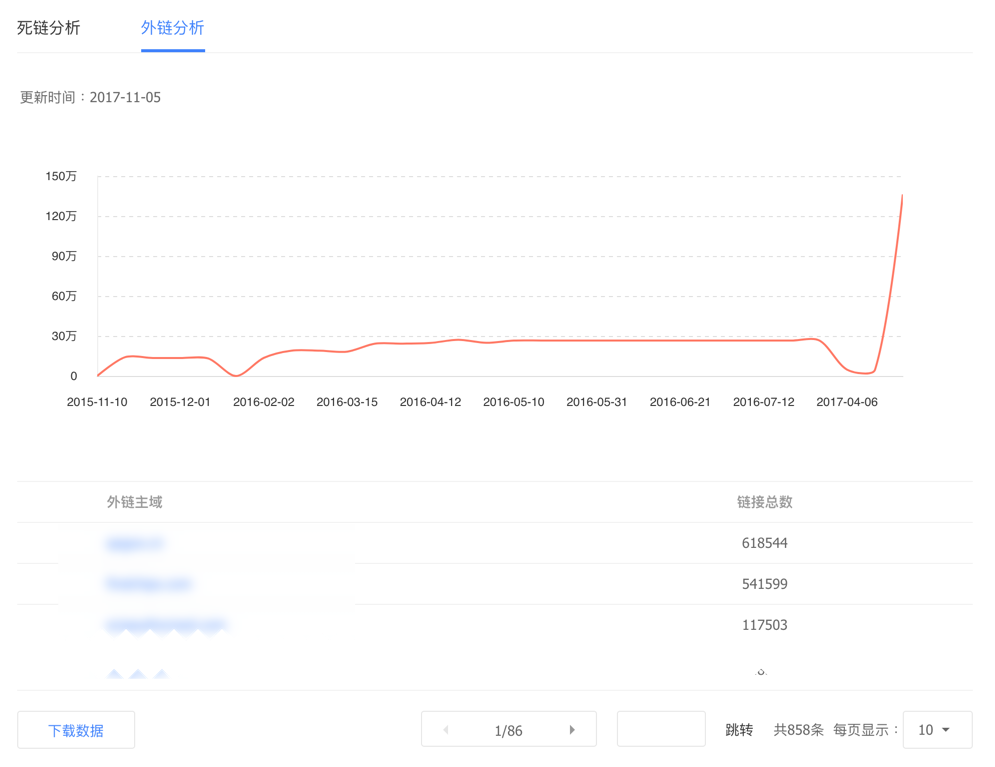
Crawling frequency is the number of times a search engine’s crawler visits a site’s server to perform a crawl within a specific period. For Baidu, crawling frequency is counted daily. Baidu Spider will automatically adjust a its crawling frequency according to its update history and server capabilities.
With Baidu Webmaster Tools, webmasters can adjust Baidu Spider’s maximum crawling frequency. It’s important to choose the right balance between frequency and performance, since a too-low crawl frequency can affect your site’s indexation on Baidu, but a too-high frequency can affect your server’s performance.
If you notice your site’s performance drop due to Baidu Spider’s crawls (you can check for Baidu Spider’s user agent in your server logs), you may want to reduce the max crawling frequency. If you’re seeing a decrease in indexation, you’ll want to increase the crawling frequency.
Baidu Webmaster Tools let you keep track on how Baidu Spider is crawling your site with their Crawl Frequency Tool:
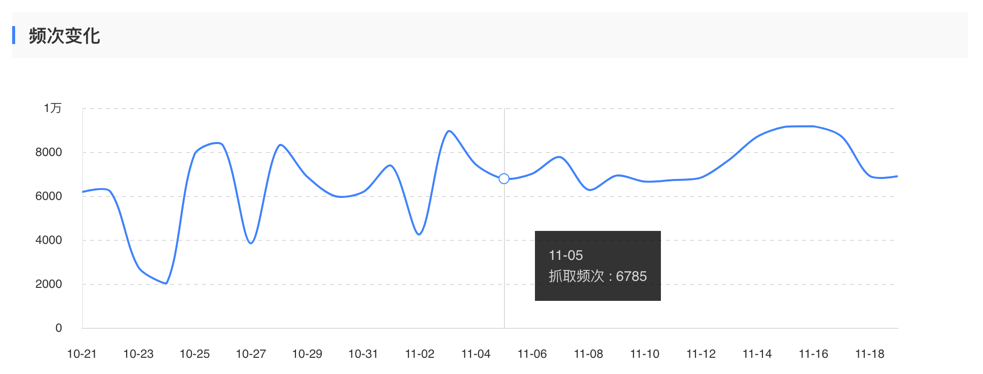
You can see number of times Baidu Spider has crawled your site each day.
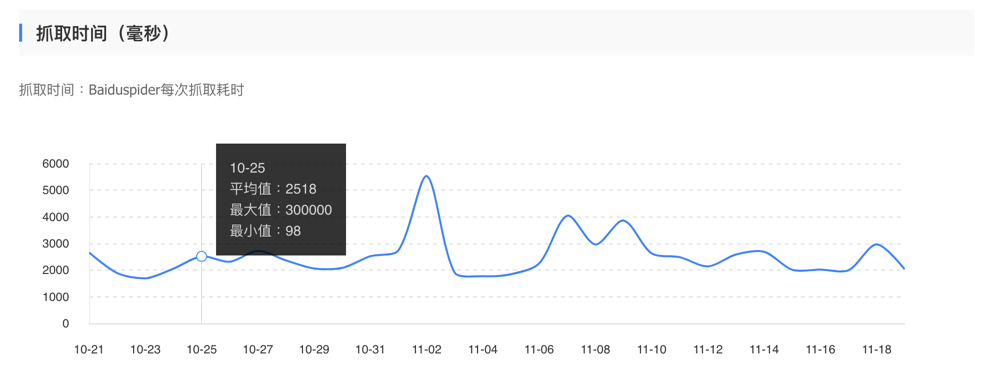
Also average time taken for Baidu Spider to crawl your site each day, in milliseconds.
So let’s say after all the analysis, you’ve decided to adjust Baidu’s maximum crawling frequency.
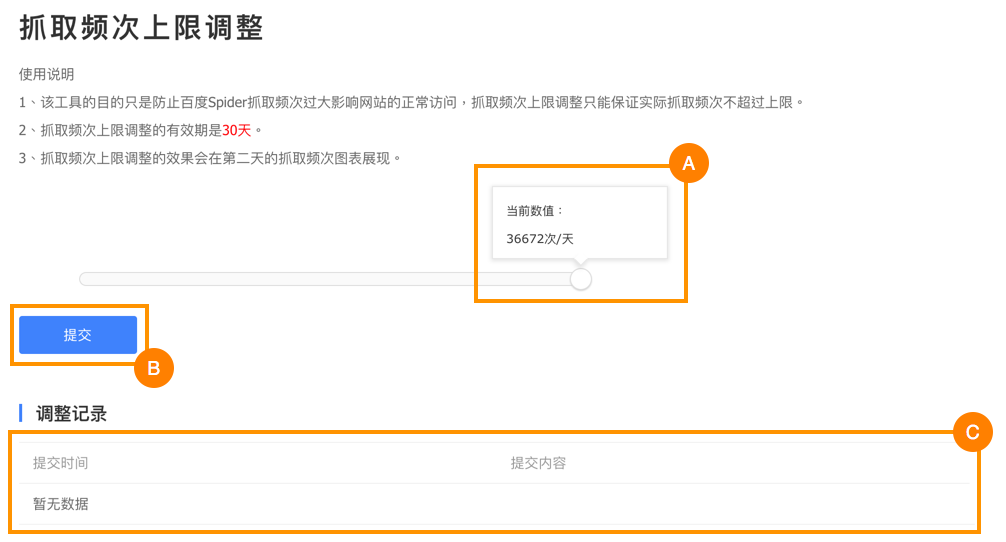
The robots.txt file is a document placed in your site’s root directory to inform search engines which pages should be crawled and which should not be crawled. With the robots tool in Baidu Webmaster Tools you can create, validate or update your robots.txt file, or check your site current robot.txt saved on Baidu.
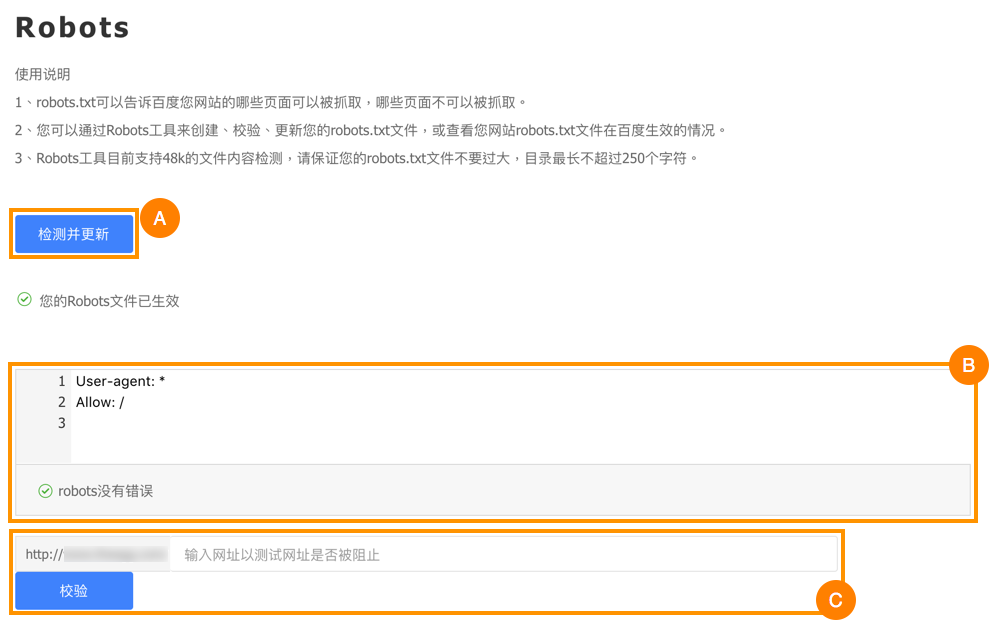
Here are some examples of setting up a good robots.txt file for Baidu:
| Applications | robots.txt |
|---|---|
| Block any search engines from crawling anywhere of the site |
|
| Allow all access to robots.txt |
|
| Only disallow Baidu Spider from crawling your website |
|
| Only allow Baidu Spider from crawling your website |
|
| Only allow Baidu Spider and Google Bot from crawling your site |
|
|
Disallow any search engines from accessing a certain pathIn this example, there are 2 subfolders blocked from search engines, please keep in mind that each path must be written in a separate row with separate directives, something like “Disallow: /members/ /admin/” won’t work |
|
| Only allow certain url to be crawled in a specific subfolder |
|
| Using “*” to restrict accessRestrict all .html content of the folder and its subfolder |
|
| Use “$” to restrict accessOnly allow .html content to be crawled |
|
| Disallow all dynamic content of the site |
|
| Disallow Baidu Spider from crawling any images on your site. Only allow pages to be crawled, disallow any images from crawling. |
|
| Only allow Baidu Spider to crawl pages and .gif files. Allow crawling pages and .gif files, disallow any other formats’ images to be crawled |
|
| Only disallow Baidu Spider from crawling .jpg images |
|
Within the Baidu Webmaster Tools, there is a Site security test (网站体检) that you can conduct, which will check your site against some basic web security issues like malicious links, cloaking, hosting vulnerability, 0-day risk etc.
The result pages will contain links to other Baidu’s web hosting products. Although it’s far from a proper server security audit but it’s good know that there’s such a tool.
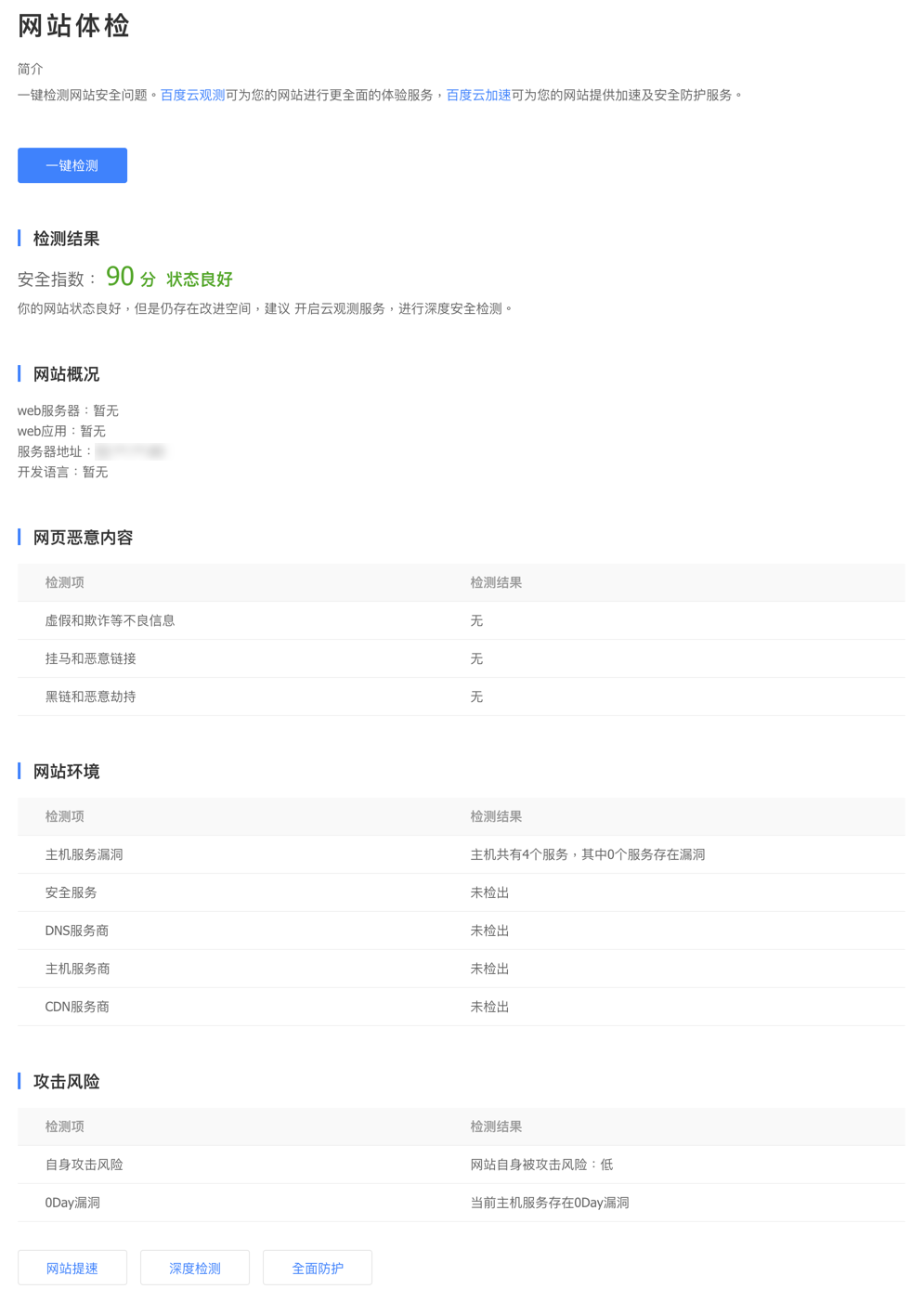
Whenever a site is not available for a relatively long period of time, Baidu will consider the site as dead, and take away its ranking power. This is an extremely detrimental unintentional consequence of site maintenance that needs to be avoided.
By applying for Closure Protection (闭站保护) in Baidu Webmaster Tools, Baidu will retain the indexation, stop crawling and hiding your site in their SERP pages temporarily, after the site is back to normal, webmasters can apply for recovery within the tool, and everything will back to as it is.
Things to keep in mind before applying for closure protection:
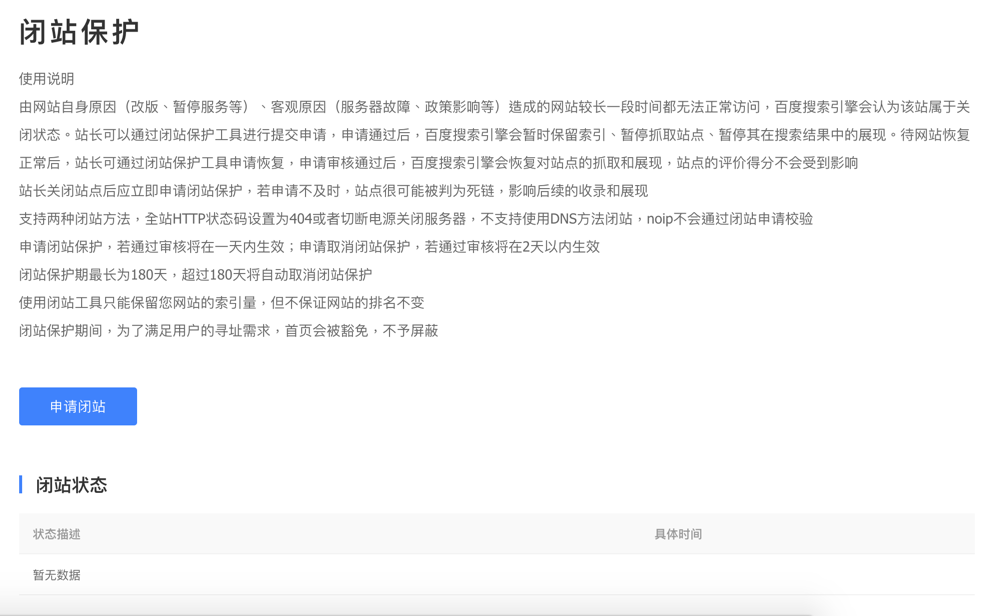
Baidu Desktop and Mobile search is vastly different, SEOs are not advised to treat it as you would Google Desktop and Mobile. The Mobile Adaption Tool in Baidu Webmaster Tools is available for webmasters to associate their site’s mobile and desktop relationship, thus increasing their potential for better mobile ranking performance.
There are 3 main types of mobile friendly websites technologies: Separate URLs, Dynamic Serving and Responsive Design
If you are using the separate URLs method, you can use the mobile adaption Tool within Baidu Webmaster Tools to tell Baidu the relationship between your desktop and mobile site.
There are two methods to use the mobile adaption tool, rules adaption and URL adaption, we will be demonstrating the URL adaption method this time, click on the 添 适配关系 (Add adaptive relationship) button to start.
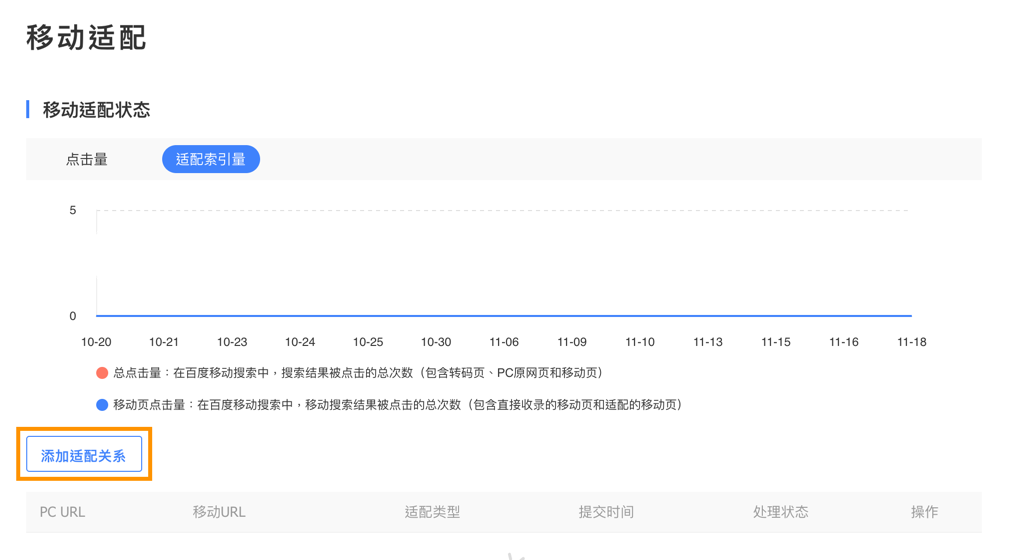
After submission, Baidu will verify your submitted rules, the process will take around 10 days. You can check back at the same page to see your results.
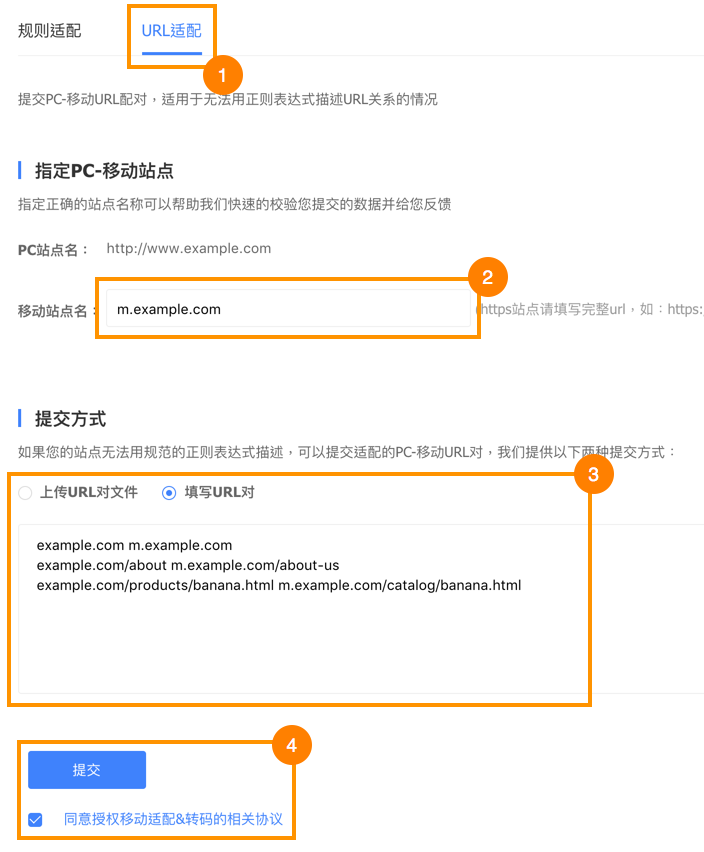
To learn more about optimizing for Baidu mobile, you’ll definitely want to check out our comprehensive guide to Baidu Mobile SEO.
Unlike Google, which is using Schema markup for structured data, Baidu SEOs must use Baidu Webmaster Tools to submit structured data. Aside from its completely different technical implementation, types of structured data webmasters are allowed to submit will be limited according to a site’s authority, credibility and participation of different Baidu beta projects. At the time of this writing, with Baidu Webmaster Tools you will be able to set the following:
Please note that submitting structured data does not guarantee your site will appear with these rich snippets — it’s up to Baidu’s discretion as to when they’re shown. We think it’s definitely worth a shot to submit data for all rich snippets that make sense for your site. If you are interested in learning more about how search appearances can affect your SEO performance in Baidu, you’ll absolutely want to check out our in-depth analysis of the Baidu SERP.
Here are some of the rich snippets available by submitting structured data through Baidu Webmaster Tools, much more examples available at our Baidu rich snippets glossary:
Add your logo or extra information about your content. Available to all webmasters.



Available to actively participants in Baidu webmasters forum
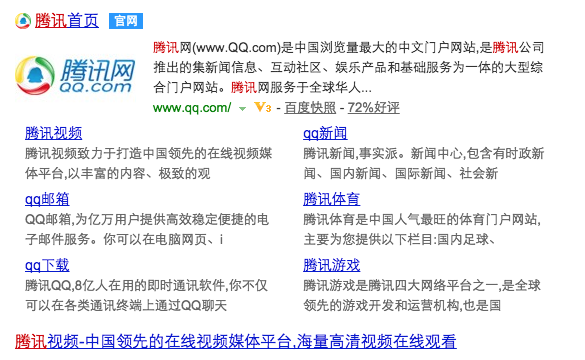
If you have a downloadable or streaming game, add a call to action button to your snippet. Closed beta, invitation based.


The Site Properties page in Baidu Webmaster Tools allow webmasters too tell more to Baidu about their sites:
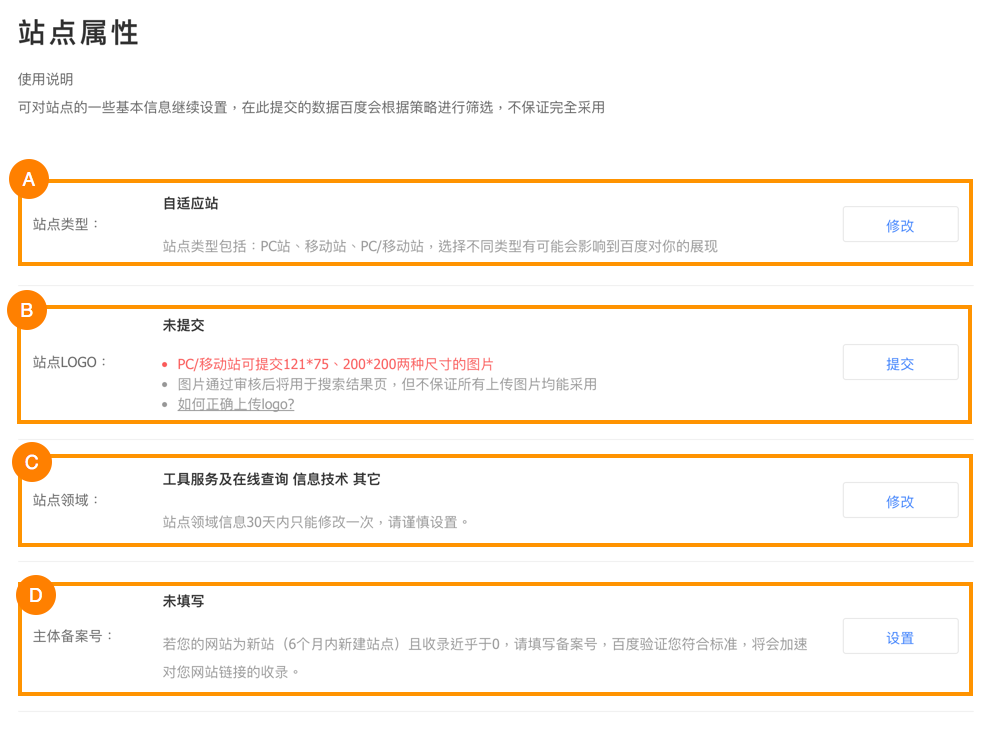
Baidu offers a mobile version of their webmaster tools with a simple and effective interface, and with a few exclusive metrics. View directly on your mobile device or use a viewport on your browser to access.

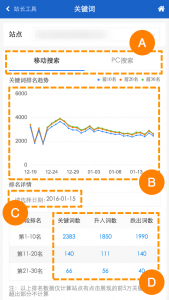
Explanation to each data columns:
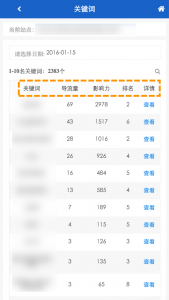
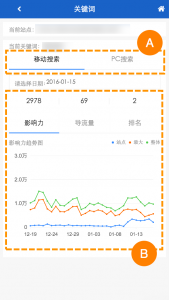
With this guide, we can now finally understand how to use Baidu Webmaster Tools to maximize your search visibility in China. While mastering Baidu Webmaster Tools may not guarantee success of your SEO campaigns, one thing is certain — not being able to use it can drastically impede your success in Baidu search results.
As Baidu Webmaster Tools is constantly updated, we’ll be updating this guide from time to time as well! We hope you find this article useful, and feel free to let us know if you have any feedback or questions!
Chapter 8 : Social Media
![]()
Chapters
Chapter 1
Chapter 2
Chapter 3
Chapter 4
Chapter 5
Chapter 6
Chapter 7
Chapter 8
Chapter 9
Chapter 10